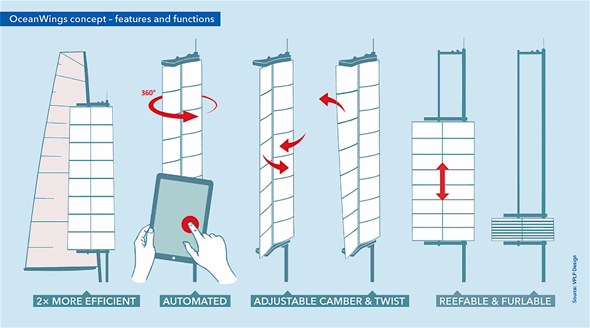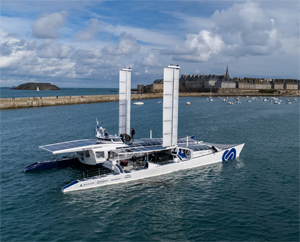Wind has never been entirely dead. But now that we have realized the ecological consequences of burning fossil fuels, and the International Maritime Organization (IMO) has imposed binding global emission restrictions, wind-assisted shipping is attracting attention again. Two French companies have shown how to use aerospace technology to double the propulsion power of wind.
The physical principle is the same one humans have used on sailing boats since eons ago: The wind hits the leading edge of the sail and splits into two flows that are redirected and travel at different speeds toward the trailing edge, causing a pressure difference that simultaneously pulls and pushes the sail and the craft forward. What has changed is the efficiency. Advanced science has doubled the amount of propulsion power per square meter of sail surface, said Marc Van Peteghem, naval architect and co-founder of VPLP Design. Together with the French engineering firm CNIM, VPLP has developed a new wing-sail concept they call OceanWings, based on an existing VPLP idea.
From plane to ship
In recent years, a number of attempts have been made to combine the propulsion principle of traditional sailing boats with the aerodynamic efficiency of an airplane wing with the trailing edge flap extended for taking off or landing. “There is a slot between the two elements of the wing, and the air going through the slot accelerates the flow and pushes the turbulence toward the trailing edge,” Van Peteghem said.
In the case of an airplane, the thrust created by the engine moves the craft against the air, causing the airflow to divide at the wings and generate the uplift force. The principle is reversed in the case of a sailing boat: The wind hits the sail rather than the sail being pushed against the wind. The physics is the same, however. Transferring the two-part concept of the plane wing and flap to a sailing boat results in a wing sail, which consists of two vertical, more or less symmetric, parallel “blades” or “wings” with a narrow gap between them. The gap splits and redirects the airflow again, reinforcing the aerodynamic effect and producing additional thrust.
The concept has been the subject of various experimental designs for some time, including inflatable as well as rigid or segmented hard-shell prototypes. While significant efficiency improvements have been achieved, controlling and reefing the sail has been complicated, requiring exceptional skill and experience.
Automated handling
The OceanWings design takes a slightly different approach. Each of the two straight blades has a mast of its own and consists of several horizontal segments, the “body” of each segment formed by a flexible fabric. Raising or lowering these segments along the mast allows the surface of the sail to be increased or reduced, or “reefed,” and lowering all segments to the lowermost position “furls” the sail entirely. The angle between the two parts of the sail can be adjusted as desired; each blade can rotate 360 degrees around its mast.
 |
The second key element of the OceanWings concept is that the complications associated with finding the proper position for the given wind condition and desired direction of travel are eliminated, as the entire wing sail is fully computer controlled. All the operator needs to do is choose the heading, and the computer will position the two parts of the sail to achieve optimum thrust, adjusting the camber and twist as required. The sail has been tested successfully on VPLP yachts — including the hydrogen fuel-cell catamaran Energy Observer launched in 2017 — and is commercially available. According to Van Peteghem, OceanWings sails can reduce fuel consumption by 18 to 42 percent, depending on ship type, route and sail arrangement.
But VPLP has far more ambitious goals than yachting. “It is time to transfer the technology we have developed in the yachting industry to the shipping industry,” Van Peteghem said. “A wing sail could be installed on any ship where it is freely exposed to the wind.”
His company advertises its OceanWings wind propulsion technology as an auxiliary source of propulsion power for merchant ships to help achieve the desired EEDI. Looking further into the future, hybrid vessels combining an eco-friendly engine fuel with wing sails and solar panels on board could one day be an option for GHG-neutral, sustainable shipping. Of course, not every sea route has the right wind conditions for such a solution, but on those routes that do, taking advantage of the wind as an inexhaustible energy source certainly makes ecological and economic sense.
Certification services
Once a new wind propulsion concept enters the commercial stage, it is the responsibility of class to ensure the system is safe and reliable, Van Peteghem said. Projects like the recent successful rotor sail installations by the MariGreen consortium and Norsepower, both with DNV GL certification, as well as OceanWings and other sail types have delivered encouraging results. To support these efforts, DNV GL published its new class notation “Wind-assisted propulsion systems” in 2019. What the industry needs now is substantial capital investments in these proven wind technologies so they can enter the mainstream and unfold their carbon abatement and fuel-saving potential.
Hasso Hoffmeister is senior principal engineer at DNV GL.

